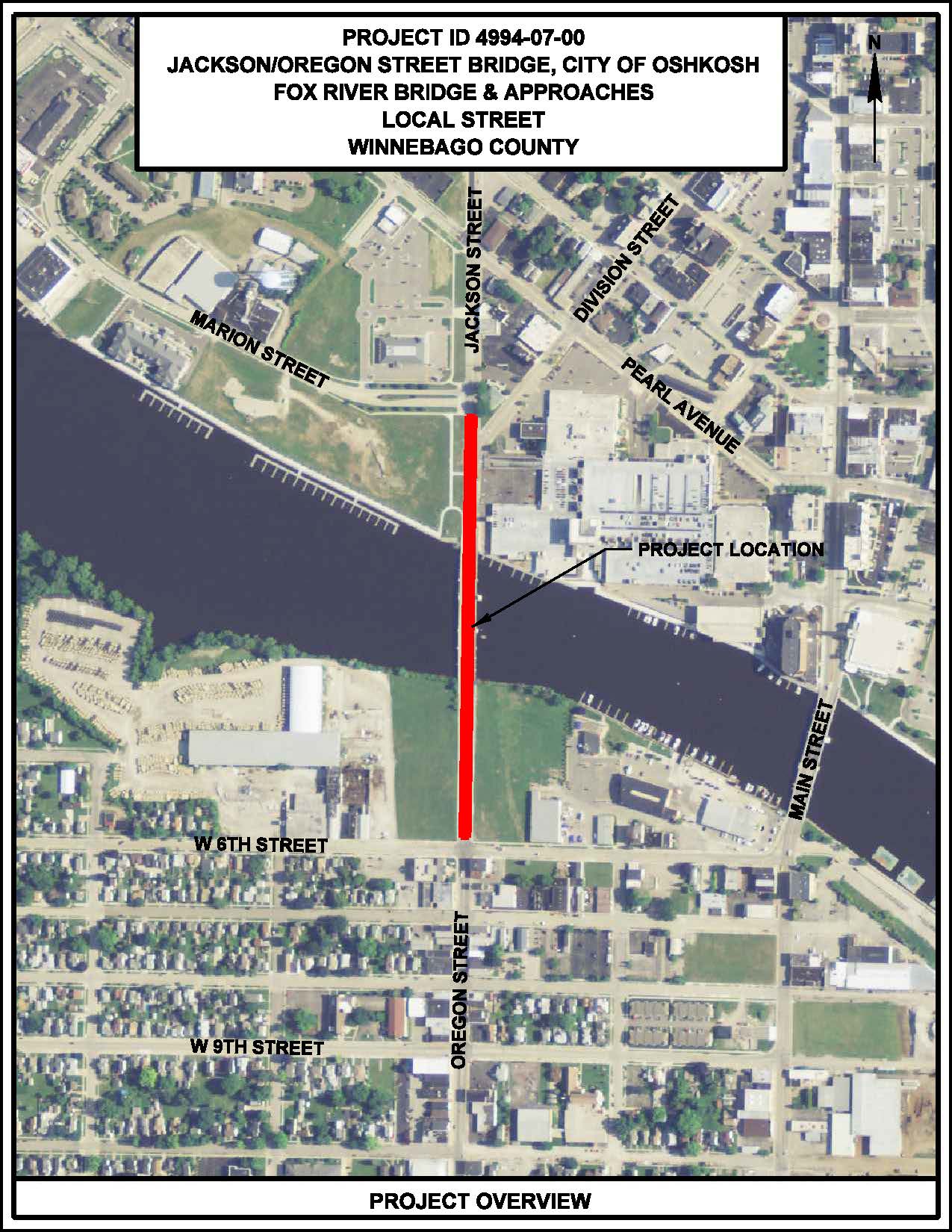PROJECT UPDATE: WisDOT selected a high-level fixed bridge on a partially offset alignment as our preferred alternative. Our environmental document with this preferred alternative was approved in February 2024, and we are now in the final design phase. A public meeting was held on Dec. 11, 2024.
Project location
Oregon/Jackson Street Bridge crosses the Fox River in downtown Oshkosh, Winnebago County.

Project overview
The existing bridge was constructed in 1956 and is nearing its service life. While the bridge is still safe for travel, bridge inspections confirmed issues that need to be addressed. WisDOT completed an environmental study that investigated a wide range of improvement alternatives and selected a high-level fixed bridge as the preferred alternative.
Status/phase
- Environmental document approved Feb. 2024
- Construction 2028
- WisDOT will conduct targeted maintenance activities on the existing bridge until construction begins in 2028. Maintaining the bridge will utilize the structures additional service life while still allowing for potential reconstruction/replacement well within the timeframe when more costly repairs are anticipated.
Need/purpose
The purpose of the project is to continue providing a safe, reliable crossing for Oregon/Jackson Street over the Fox River. This bridge improvement will address structural and geometric deficiencies of the existing bridge, maintain safe access and passage for all users including motorists, bicyclists, pedestrians, persons with disabilities, and waterway users, meet transportation demand, and comply as much as possible with all state, regional and local plans, including city redevelopment planning.
Current bridge deficiencies
WisDOT bridge engineers determined the bridge is safe and structurally sound, and there are no significant safety concerns to traveling public that would necessitate a high-cost improvement project prior to 2028. While scheduled and preventative maintenance will allow WisDOT to utilize the remaining service life of the existing bridge, there are deficiencies that have been grouped into three general areas (deficiencies, operations, safety). These deficiencies do not compromise safety of the traveling public and many of he deficiencies can be addressed with maintenance operations until the 2028 bridge replacement project.
Bridge deficiencies
- Movable bridge machinery shows signs of wear and corrosion and needs replacement
- Deterioration of tack welds and steel plates require repair
- Cracking and spalling on concrete surfaces of bridge piers
- Sidewalks are less than the standard widths
- Approach spans and sidewalks need repair
- Vertical profiles of roadway approaches are below current design standards
Bridge operations
- Bridge tender has poor visibility to monitor vehicles and pedestrians when raising the bridge
- Low vertical clearance – Bridge had 400 more openings in 2015 than adjacent bridges
Safety
- Vehicle crash rate is above statewide average for similar roadways
- Bridge railing of bascule span is offset into sidewalk, creating potential hazards for pedestrians and bicyclists
- Narrow lane and sidewalk widths do not provide safe bicycle accommodations
- Riverwalk pedestrians and bicycle traffic are required to cross road at grade (cannot cross under bridge), creating a mid-block, at-grade pedestrian crossing
- Steel grid panels in deck are offset and present a hazard to bicyclists
- Approach sidewalks have settled and present a tripping hazard
Benefits of high-level fixed bridge improvement
- Improved safety – A desirable width and profile that should improve safety for all users.
- Increases bridge width to accommodate 11-foot travel lanes as well as 5-foot bicycle lanes and 6-foot sidewalks on both sides.
- Improved traffic flow/boat passage – 23-foot vertical clearance allows for all boaters to pass under the bridge without a need for a lift span.
- Current navigation clearance is 2-3’ less than adjacent bridges. An improved navigation clearance results in less delay for boaters and less traffic congestion in the downtown area from bridge openings.
- Improved multi-modal opportunities - Better accommodations for bicycle and pedestrian travel and links to the river walks on both shores, including the separation of river walks under the new bridge.
- Less future impact – Provides a bridge life of roughly 75 years before the next major bridge improvement is required.
- A high-level fixed bridge will require much less maintenance, and the costs associated with maintenance, when compared to a bridge that opens.
- Provides a continuous river crossing without interruptions for emergency services.
Contacts
Bill Bertrand, P.E., WisDOT Project Manager
(920) 360-3124
william.bertrand@dot.wi.gov
Tammy Rabe, P.E. WisDOT Project Supervisor
(920) 445-9072
tammy.rabe@dot.wi.gov
Mark Kantola, WisDOT Communications Manager
(920) 492-4153
mark.kantola@dot.wi.gov
Wisconsin Department of Transportation (WisDOT)
Northeast Region
944 Vanderperren Way
Green Bay, WI 54304